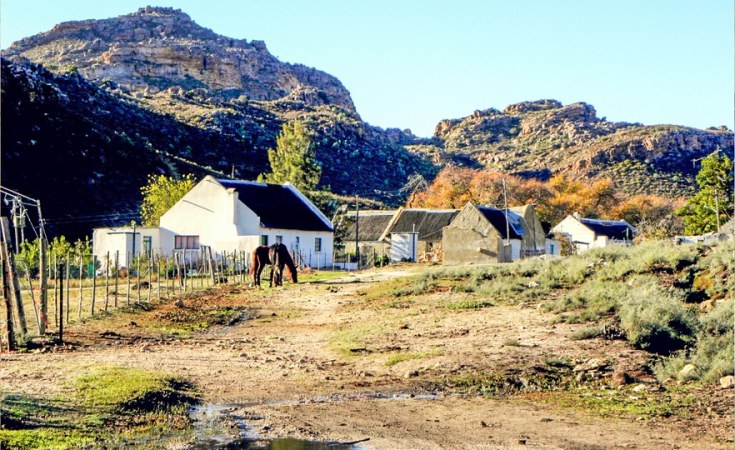Resounding History: Cederberg's Ancient Place Names Echo Through Time

The Cederberg mountain range in the Western Cape, South Africa, has captivated people for tens of thousands of years, fostering a rich lexicon of evocative vernacular place names. These names, describing remote, tiny settlements, historic farms, prominent geographical features, and highly diverse local flora, collectively form a unique “Sense of Place” that is now a highly valued element of South Africa's cultural and natural heritage.
Renowned South African cartographer Peter Slingsby, 78, has made a significant contribution to popularizing and protecting this heritage, particularly within the Cederberg. Best known for his popular series of maps covering hiking, tourism, and nature destinations across the country, Slingsby holds the Cederberg closest to his heart. His lifelong passion for the region began at age 17 during an overnight hike in its wild higher peaks, leading to many subsequent excursions dedicated to documenting, mapping, and celebrating the area.
A crucial aspect of Slingsby's contribution has been his meticulous effort to record and curate hundreds of place names formerly known only through the oral traditions of small communities with very limited vehicle access. This quest is thoroughly detailed in his new book, which was launched earlier this month. Slingsby explains his lifelong fascination with place names and their meanings, stating that as a cartographer who has spent many fulfilling hours mapping the Cederberg, he cannot discuss its “Sense of Place” without invoking these often beautiful vernacular names that provide frame and reference to anywhere frequented by human beings.
The broad sweep of human history in the Cederberg began with the San (or /Xam) hunter-gatherers, the sole human occupants for perhaps 30,000 years or more, leaving a legacy on rock walls and in genes. Their sustainable existence was upended with the appearance of Khoi herders about 2,000 years ago, and then, dramatically more so, with the arrival of Dutch and English colonists starting in the mid-17th century. Historically, this concentrated melting pot of human activity, language, and biodiversity in a dramatic landscape produced a very rich vocabulary of vernacular place names. Sadly, many – particularly those of the San and Khoi – have been forgotten, replaced, or superseded by Dutch colonial and later Afrikaans names, though Slingsby notes that some of these later names carry the same ancient meanings as the old languages.
Several of the Cederberg's dramatic, often other-worldly, geological features have become household names: Stadsaal, Maltese Cross, Wolfberg Cracks, Wolfberg Arch, The Chockstone, Truitjieskraal, and Lot's Wife. Slingsby finds it “extraordinary, unbelievable” that rocks like these form the heart of the Cederberg's unique Sense of Place, with their enduring presence in the human imagination. Yet, he questioned why the names of some other elements in this landscape were not also recorded on maps, remaining solely in the less reliable and vulnerable realm of oral history.
This question came into sharp focus when a friend lent Slingsby M.I. Murray's 1989 book, “Witwater se Mense” [Whitewater's People]. The book, an “utterly engrossing” tale of a young girl's life in the tiny hamlet of Witwater – an outlier of the historic Wupperthal mission station, along with its neighbor Heuningvlei – contained numerous place names absent from any existing maps. Intrigued, Slingsby and his wife Maggie visited Heuningvlei to investigate. Initial disappointment arose when five or six village elders denied knowing the names he had culled from the book. However, one elder, the late Joey Ockhuis, had a lightbulb moment, exclaiming, “Ek ken daai name! Dis almal Witwater se name!” [I know those names! They're all Witwater's names!]. Slingsby recounts this part of the story with his characteristic dry wit, highlighting the realization that Heuningvlei, being six kilometers from Witwater, naturally meant its residents wouldn't recognize specific Witwater names.
This breakthrough led Slingsby to Witwater and its surrounding area where other elders not only pointed out every name mentioned in Murray's book but, to Slingsby's delight, many others as well. That day, nearly two hundred names were collected, names that had never been on maps before and would have been lost forever if not recorded – including Sitkoppie, Brandysterklip, Kerniekelsfontein, Giel se Knik and, reflecting the ancient myths of the area, Watermense se gat. Follow-up visits yielded more than 150 additional “new” old names from other elders, such as Kloekie se Klip, Santjie se Werf, Bokdrif and Skoenmakerspoort.
Slingsby emphasizes that the key to uncovering this trove of names was taking the time to appreciate the experiences of people living without motorized transport. He explains that “When everyone is driving around, place names get forgotten because they're not really needed any longer. But when you live without a vehicle, you know the name of every landmark. Every corner, every hill, every bend ... everything is a place to you. You see everything, it's like walking a trail.” This philosophy underpins his trail maps, where place names are deemed essential for their utility.
The impact of Slingsby's dedication is clearly visible in his Cederberg maps. The first edition, published in 2013, incorporated close to 300 previously unrecorded place names. By the time the current fifth edition appeared late in 2024, this number had grown to include close to 500 names never previously recorded on maps. Slingsby firmly insists that “Rather like a written history of events, it's ultimately the only way that place names get properly remembered.” His new book, “Cederberg - The Book,” is published by Tracks4Africa.
Recommended Articles
South Africa's Western Cape Tourism Sparkles Globally!

The Western Cape has achieved global recognition for its tourism and wine industries, with several provincial initiative...
Western Cape's Nature Reserves Go Fully Digital with 'Cashless Revolution'

CapeNature announces a groundbreaking cashless system for five Western Cape reserves, modernizing tourism with secure di...
You may also like...
Flick's Fiery Vow: Barca Coach Promises Redemption After Humiliating Chelsea Defeat!
)
Barcelona suffered a significant 3-0 Champions League defeat to Chelsea, compounded by Ronald Araujo's red card. Despite...
Real Madrid's Shocking Bid for Osimhen Amid Vinicius Drama!
)
Real Madrid is reportedly targeting Galatasaray's Victor Osimhen for a major attacking overhaul, spurred by tactical res...
From Shocking Axe to New Dawn: 'The Office' Remake Rises from the Ashes!

The international legacy of <i>The Office</i> continues with the cancellation of its Australian iteration and the upcomi...
One Piece Fans Erupt in Fury Over Netflix's Latest Project!

Toei Animation's HD remasters of One Piece on Netflix have sparked fan outrage over cropped visuals and alleged AI upsca...
Literary Buzz: Unveiling Tiisetso Maloma's 'Ubuntu Stoicism' Excerpt

Ubuntu is a profound African philosophy rooted in the Nguni and Bantu languages, symbolizing humanity, togetherness, and...
Global Spotlight: Uganda Dazzles Havana with Unrivalled Tourism and Investment Opportunities!

The Uganda Embassy in Havana is participating in the 41st Havana International Fair (FIHAV 2025) to bolster bilateral tr...
Uganda's New Gem: Beri Cottages Unlocks West Nile's Untamed Beauty!

Beri Cottages, a charming boutique guesthouse outside Arua town in Uganda's West Nile region, offers a serene yet conven...
Critical Health Alert: Dangerous Combinations - What NOT to Mix with Vitamin C
:max_bytes(150000):strip_icc()/Health-GettyImages-SupplementsNotToMixVitaminC-4cd93a8dd99a4e1d8ce55574ad4d7a60.jpg)
Vitamin C, or ascorbic acid, is vital for health but can interact with various supplements and medications. Learn how it...